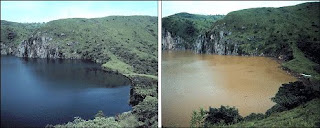Thursday, April 28, 2011
Limnic eruptions typically occur in volcanic lakes, which are able to hold a great quantity of dissolved CO2 gas due to the heavy pressure in their deep bottoms. Veins of magma release heat and gasses into the water from underneath. There may be as many as 5 liters of CO2 for every liter of water, and it all comes up when something disturbs the delicate balance of layers. The disturbance could be anything – an underwater rock slide, a change in temperature, sinking surface waters – but all lead to the gas-heavy water rising and the CO2 exsolving from the water. As the water and gas rise, there is less pressure, so more and more gas is released. The other gas-heavy water follows in the wake of the first, releasing its gas as well. Eventually, the whole lake undergoes lake overturn and all the deep water is now at the surface.
Subscribe to:
Post Comments (Atom)


No comments:
Post a Comment